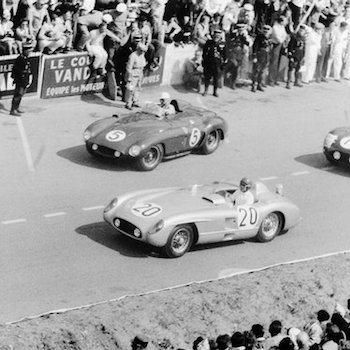We are but a matter of weeks away from the famous 24 Hours of Le Mans. Here at wec-magazin.com, we would like to take a look back at some of the highlights of the legendary race. Each article in the series will be dedicated to a certain individual, car or other feature in Le Mans history that are particularly meaningful to wec-magazin.com.
It’s the 1950s, following a break for the second world war, the 24 Hours of Le Mans are being held once again in western France. The fierce combat of the war years was fresh in the memories, and the mood in Europe was still a tense one. No wonder, then, that this sentiment was also reflected in the motor racing scene of the age. Germany was represented at Le Mans by the all-conquering Mercedes-Benz team, while Jaguar were the great British hopes for the race. It was a ruthless battle for supremacy, and fuelled some of the greatest leaps forward in automotive development. Jaguar developed disc brakes, far superior to Mercedes’ drum brakes. To even out the advantage, Mercedes came up with an air brake system to slow the cars down.
Motor racing in the 1950s was an era in which regulations were only loosely defined. The battle to stay at the cutting edge of technology led to all manner of curious developments among the constructors. In 1952, French driver Pierre Levegh entered the race in his own team together with René Marchand. The privateer team entered a Talbot-Lago, which, although quick around the circuit, was unable to keep pace with the big works teams. Early in the race, pole-sitter Alberto Ascari in a Ferrari soon built up a lead but was forced to retire with clutch problems after just three hours. The Behra/Manzon Gordini then took the lead, which it was able to defend until halfway through the race. But then a brake defekt on the small 2.3 litre car also forced them to retire. With all of the works Ferraris, a Mercedes and all the Jaguars also retiring, the Levegh took the lead in his unfancied Talbot-Lago.
In those early days, there were no limits on how long a driver could spend in the car. At the time he took the lead, he had been driving for the entirety of the first 12 hours without a break. The car was suffering from engine damage, but was able to continue. Throughout the rest of the race, Levegh would regularly pit to fill up on fuel but never left the car, even though his teammate René Marchand was ready to take over. Just one hour and ten minutes before the end of the race, an exhausted Levegh cruised to a halt on the Mulsanne straight, his Talbot-Lago unable to move another inch. He lost the race, but went down in history as the man who came closest to winning the 24 Heures alone. He had driven for 22 hours and 50 minutes without a break, the greatest driving achievement ever seen at Le Mans. An entire day at the wheel of a racing car without anything significant to eat or drink and without any sleep whatsoever. It was never said why Levegh didn’t let his teammate take over. Rumours suggest Levegh was concerned that the less experienced Marchand would irreparably damage the engine if he were to get into the car.
Three years later, the Mercedes-Benz works team signed Pierre Levegh as a replacement for the injured Hans Herrmann. The 1955 24 Hours of Le Mans was to be Levegh’s last motor race. A collision between an Austin-Healey and Levegh’s Mercedes resulted in the greatest tragedy in the history of motorsport, in which Levegh and 82 spectators lost their lives.
Image sources: Mercedes AMG F1 / Wikipedia

